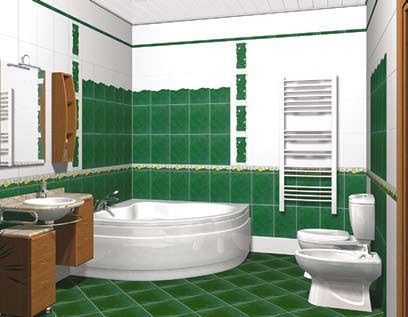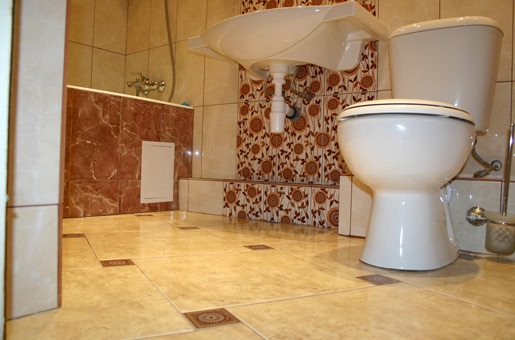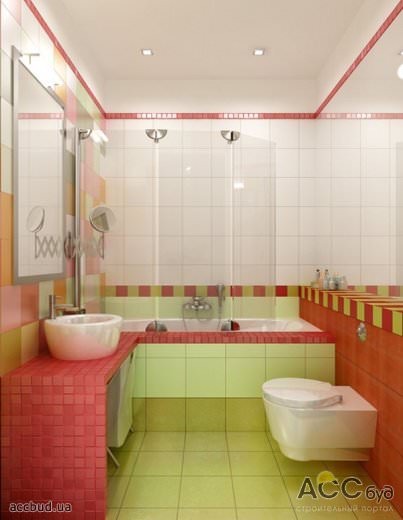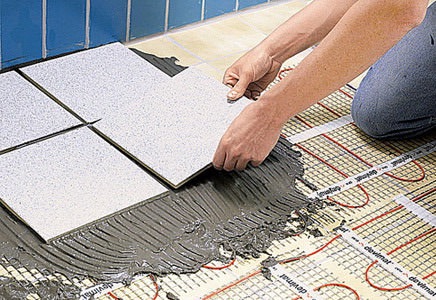What is the best bathroom floor tile?
During the repair period, a problem regularly arises related to what should be the tiles for laying on the floor in the bathroom. In this case, it is necessary to be guided by several factors at once:
- fortress,
- ease of installation
- ease of use,
- design.
Indoors and earlier, and now almost all professional builders advise using tiles for the bathroom (both wall and floor). Here, an important role is played mainly not only by a neat appearance. but also the fact that this tile is ideal for the bathroom floor, as it does not allow moisture to pass through it.
The main types of bathroom tiles
There are 2 main types that can be used to put:
- clay (skull),
- ceramic.
The advantages of cranial material include the following:
- This type of floor is easy to clean, since it is practically in no way exposed to the negative effects of dust and harmful microorganisms, and can also be washed with absolutely any cleaning agent (they will not harm it).
- Clay tiles are recognized as an environmentally friendly substance.
- A wide selection of tiles allows you to purchase exactly the material that you intended to use (both in size, and in shape, and in color).
As for it, unlike many other materials, it practically does not conduct electricity, which makes laying the bathroom floor with ceramic tiles absolutely necessary, since you can not be afraid that moisture will lead, for example, to a short circuit.
According to the opinion of experts in this field, it is necessary to select floor tiles first when repairing or initial finishing a bathroom. And after that it will be possible to move on to solving issues related to the choice of furniture and plumbing.
How to choose the right bathroom floor tiles?
When choosing a tile for the bathroom floor, you need to be as careful as possible, paying attention not only to the external features of the material, but also to its working properties. Therefore, carefully consider and analyze the markings of the tiles.
You can find this marking on the packaging with. Thus, it is possible to determine that this material is suitable for laying the floor by the icon in the form of a foot outlined in dark color, and the image of the hand demonstrates that the material is intended for wall cladding.
If you see an image of a foot with a drawn background, then you can use the tile in almost any environment, as it has increased strength.

In the process of choosing a tile that is suitable for laying the floor in the bathroom, it is also necessary to take into account the fact that the floor itself, and even its walls, may not always meet the requirements that apply to such an event as. In addition, tiles often come into contact with cleaning products, perfumes and numerous chemicals during operation. In this regard, try to choose a tile that can withstand the effects of acids, alkalis and other harmful compounds on it.
The main options for ceramic tiles for laying the floor in the bathroom
This finishing material is divided into 2 options:
- bathroom tiles on the floor,
- tiles on the walls.
When choosing the first version of the tile, it is necessary to take into account the safety of using it in this particular room. The fact is that in conditions of high humidity in this room you will need to purchase exclusively tiles with a rough, matte surface. After all, the floor in the bathroom most often turns out to be damp, and accordingly, it will be quite easy to slip on it. It is in order to avoid such unpleasant situations, avoid purchasing tiles with a smooth surface.
Porcelain tile is not slippery due to the fact that its surface does not allow moisture to pass through. Currently, when implementing such a repair process as laying tiles on the floor, in addition to a rough opaque tile, a special ribbed tile is used, in which there are small grooves designed to drain water. Such a tile will cost much more than a regular one.
Another type is considered to be mosaic floor tiles. Its merits include:
- material reliability.
- easy laying on the floor.
- beautiful appearance, especially when combined with tiles of very large sizes.
- ability to withstand the damaging effects of moisture.

When choosing a tile, it is necessary to take into account that each seam between the tiles will not be strong enough, therefore, after laying, it will be necessary to process each seam with a special grout.
The main stages of laying tiles on the floor in the bathroom
So, after you have purchased a sufficient amount of flooring tiles, you need to move on to the process of laying them. It also consists of several stages. First of all, here you will need to level the subfloor. If it is necessary to have a very strong alignment (more than 25 mm), then a cement-sand screed is used. If the floor is even or the deviation is not so significant, then there is no need to resort to leveling. you can easily smooth out this unevenness with a slightly thickened layer of tile adhesive.
In addition, before laying the tiles, it is necessary to carry out the floor. To do this, it is recommended to impregnate the surface with its special waterproofing compound. This can be done even from the underground (if there is such a possibility).
Alignment includes the following steps:
- First, mark the level of the future floor around the entire perimeter of the room. This is done on the walls with a pencil or chalk.
- Next, beacons are placed, made with the help of planks, bars, etc.
- Beacons are fixed so that they remain stationary. At the same time, it is worth remembering that they are installed in increments of 100-150 cm.
- The first beacon is installed from the wall at a distance of 100-150 mm. Do not forget about the need to check their position every time using the building level.
- After the beacons are leveled, they are reinforced with concrete mortar or tile adhesive (if the leveling is planned to be small).
- Next, you need to level the new surface along the beacons with a trowel or spatula.

So, to level the floor you will need:
- concrete mortar (1 hour cement, 1 hour water, 3 hours sand),
- wooden slats or planks,
- Master OK,
- putty knife,
- building level,
- roulette.
Laying tiles on the floor
On a flat dry surface of the new floor, you can already lay tiles. First you need to prepare the glue, for which the dry mixture is diluted in water (the proportions are indicated on the package). Next, take 2 spatulas, 1 of which will be regular, and 2 - notched. First, glue is applied to the floor with a simple spatula (if not, you can even use a trowel), and then this solution is leveled with a notched tool. This will allow the tile to better adhere to the mortar. Next, you just have to lay the tile and press it down well to the floor. If this fails, then use either a wooden or rubber mallet.

Thus, in order to do everything right and get exactly the result that you were trying to achieve, you need to choose the right material. Therefore, remember that floor tiles must be strong, beautiful and not smooth.
Laying tiles on the floor yourself. Video






